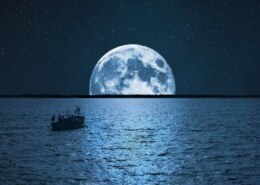Imagine standing at the edge of the ocean, watching the water retreat and then rush back in a rhythmic dance that repeats day after day. This captivating ebb and flow of the tides shape not only our coastlines but also influence rivers and estuaries far inland. But what orchestrates this constant movement? The answer lies far above us — in the silent, celestial pull of the Moon.
Let’s dive into the fascinating world of tides and explore how the Moon controls the behavior of our oceans and rivers.
🌙 The Moon’s Gravitational Pull: Nature’s Invisible Hand
The tides are primarily caused by gravity, the invisible force that keeps the Moon in orbit around the Earth. But this same force doesn’t just hold celestial bodies in place — it also pulls on the Earth’s oceans.
-
When the Moon’s gravity pulls on the Earth’s water, it creates a bulge — a rise in sea level — called the high tide.
-
On the opposite side of the Earth, another high tide occurs due to the centrifugal force caused by the Earth-Moon system’s rotation.
-
Between these bulges, the water level falls, causing low tides.
This gravitational dance results in the familiar two high tides and two low tides each day in most coastal areas.
🌊 Ocean Tides: The Big Picture
The ocean tides can be influenced by several factors, including:
-
The Sun’s gravity: Though the Moon has a stronger effect due to its proximity, the Sun also tugs on Earth’s waters, sometimes amplifying or diminishing the tides.
-
The Earth’s rotation: This causes the tides to move across the globe, creating tidal cycles.
-
Local geography: Coastlines, ocean basins, and underwater topography can affect the height and timing of tides.
🌿 Tides in Rivers: The Pulse of Estuaries
Many rivers that flow into the sea experience what’s known as a tidal bore — a sudden surge of water that moves upstream against the current during incoming high tides.
This happens because:
-
When the ocean’s tide rises, it pushes saltwater into the river’s mouth.
-
In narrow or shallow rivers, this creates a wave or “bore” that travels upstream.
-
The result? A fascinating natural spectacle that can travel miles inland.
🌕 Special Tides: Spring and Neap
The tidal forces don’t stay constant throughout the month:
-
During new and full moons, the Sun, Moon, and Earth align, and their gravitational pulls combine to create spring tides — tides with the greatest difference between high and low water.
-
During the first and third quarters of the moon, when the Sun and Moon are at right angles, neap tides occur — tides with the least difference between high and low water.
These cycles play a crucial role in coastal ecosystems, navigation, and even fishing.
Why Tides Matter
Tides influence many aspects of life on Earth:
-
They shape coastal habitats, affecting plants and animals adapted to the changing water levels.
-
They impact human activities, from fishing and shipping to coastal engineering.
-
In some places, tides can be harnessed as a source of renewable energy, using tidal turbines to generate electricity.
In Conclusion
Next time you watch the waves roll in or see a river surge with saltwater, remember the Moon’s gentle but powerful pull. This cosmic connection reminds us that our planet is part of a vast, interconnected system — one where even a distant rock in space shapes the rhythms of life here on Earth.
The tides are more than just water moving; they’re the heartbeat of our blue planet, guided by the Moon’s timeless dance.

